Magic 8 Ball
This article needs additional citations for verification. (September 2019) |
 The Magic 8 Ball | |
| Type | Novelty toy |
|---|---|
| Inventor(s) | Albert C. Carter Abe Bookman |
| Company | Mattel |
| Availability | 1950–present |
| Materials | Plastic Alcohol Blue coloring |
| Official website | |
The Magic 8 Ball is a plastic sphere, made to look like an oversized eight ball, that is used for fortune-telling or seeking advice. It was invented in 1946 by Albert C. Carter and Abe Bookman and is currently manufactured by Mattel. The user asks a yes–no question to the ball, then turns it over to reveal an answer in a window on the ball.
Origin
The functional component of the Magic 8 Ball was invented by Albert C. Carter, who was inspired by a spirit writing device used by his mother Mary, a Cincinnati clairvoyant.[1] When Carter approached store owner Max Levinson about stocking the device, Levinson called in Abe Bookman, Levinson's brother-in-law, and graduate of Ohio Mechanics Institute. In 1944, Carter filed for a patent[2] for the cylindrical device, assigning it in 1946 to Bookman, Levinson and another partner in what came to be Alabe Crafts, Inc., combining the founder's names, Albert and Abe. Alabe marketed and sold the cylinder as The Syco-Slate. Carter died sometime before the patent was granted in 1948. Bookman made improvements to The Syco-Slate, and in 1948 it was encased in an iridescent crystal ball. Though not successful, the revamped product caught the attention of Chicago's Brunswick Billiards, who in 1950 commissioned Alabe Crafts to make a version in the form of a traditional black-and-white 8 ball,[3] which was possibly inspired by a gag in the 1940 Three Stooges short film, You Nazty Spy!.[4]
Cultural impact
Although originally sold as a paperweight, the Magic 8 Ball would remain popular for several decades. It was popular as both an office toy and a children's toy. [citation needed]
In 1971, Bookman sold Alabe Crafts, Inc., to Ideal Toys[5] who marketed the ball firmly at children. In 1987, the rights were again sold to Tyco Toys,[6] spurring on another marketing campaign and resurgence in interest. Despite its numerous owners, the Magic 8 Ball has changed little in design and implementation.
Design and usage

The Magic 8 Ball is a hollow plastic sphere resembling a black-and-white 8 ball. Its standard size is larger than an ordinary pool ball, but it has been made in different sizes. Inside the ball, a cylindrical reservoir contains a white plastic 20-sided regular icosahedron die floating in approximately 100 ml (3+1⁄2 US fl oz) of alcohol dyed dark blue. Each of the die's 20 faces has an affirmative, negative, or non-committal statement printed in raised letters. These messages are read through a window on the ball's bottom.
To use the ball, it must be held with the window initially facing down to allow the die to float within the cylinder. After asking the ball a yes–no question, the user then turns the ball so that the window faces up. The die floats to the top, and one face presses against the window; the raised letters displace the blue liquid to reveal the message as white letters on a blue background. Although most users shake the ball before turning it upright, the instructions warn against doing so to avoid white bubbles.
While the Magic 8 Ball has undergone very few changes, an addition in 1975 by new owners, Ideal Toy Company, fixed the bubble problem.[7] Their patented "Bubble Free Die Agitator", an inverted funnel, rerouted the air trapped inside. The solution has been utilized ever since.
Possible answers
A standard Magic 8 Ball has twenty possible answers, including ten affirmative answers (●), five non-committal answers (●), and five negative answers (●).
|
● It is certain. |
● As I see it, yes. |
● Reply hazy, try again. |
● Don't count on it. |
Electronic version
An electronic version appeared in a 1980 issue of Popular Electronics magazine as a construction project. It expanded the number of possible answers from 20 to 63. The Magic Black Box used a ROM to generate the 16-character alphanumeric messages on a seven-segment LED display. It could not generate K, M, V, W, or X but it could generate a question mark. Upon power-up, it displayed "your QUEstIOn?" This odd capitalization was a result of the seven-segment display's limited ability to output letters. A momentary push of the answer button picked a random message which was then displayed. Of the 63 possible answers, 25 were affirmative answers, 25 were negative answers, and 13 were non-committal answers.[8]
Film adaptation
A live-action horror film based on the toy was reportedly in development in 2021 at Blumhouse Productions, with Jeff Wadlow signed on as the director.[9][10] In August 2022, Blumhouse announced it was no longer producing the movie.[11]
See also
Patents
- U.S. patent 2,452,730—Liquid Filled Dice Agitator ca. 1944
- U.S. patent 3,119,621—Liquid filled die agitator containing a die having raised indicia on the facets thereof, 1962
- U.S. patent 3,168,315—Amusement Device ca. 1961
References
- ^ "Where Did the Idea for the Magic 8 Ball Come From?". Encyclopedia Britannica. Retrieved 2021-04-14.
- ^ Coopee, Todd. "Magic 8 Ball from Alabe Crafts (1946)". ToyTales.ca.
- ^ Walsh, Tim. (2001). The Playmakers: Amazing Origins of Timeless Toys, pp. 94–5. Keys Publishing, Sarasota. ISBN 0-9646973-4-3.
- ^ Minichiello, Mia (2015). "The Great Dictator (film)". Salem Press Encyclopedia. Salem Press.
- ^ "A Brief History of the Magic 8 Ball". www.mentalfloss.com. 2015-08-24. Retrieved 2021-06-04.
- ^ "Abe Bookman, UC alum, created everlasting Magic 8 Ball". University of Cincinnati. Retrieved 2021-06-04.
- ^ "Today I Found Out". Today I Found Out.
- ^ Friese, Michael (January 1980). "Electronic Magic Box" (PDF). Popular Electronics. 17 (1): 61–66. Retrieved 30 December 2021.
- ^ D'Alessandro, Anthony (June 3, 2019). "Mattel Films & Blumhouse Team For 'Magic 8 Ball', 'Truth Or Dare's Jeff Wadlow Set To Direct". Deadline Hollywood. Retrieved September 18, 2021.
- ^ Whitten, Sarah (July 25, 2019). "Mattel is making a Magic 8-Ball movie with horror movie titan Blumhouse". CNBC. Retrieved September 18, 2021.
- ^ Whitten, Sarah. "Blumhouse, studio known for highly profitable horror films, is no longer producing Mattel's Magic 8 Ball movie". CNBC. Retrieved 2022-08-14.
External links
- "The Inscrutable Magic 8 Ball Revealed!". eBaum's World. Retrieved September 24, 2017.

